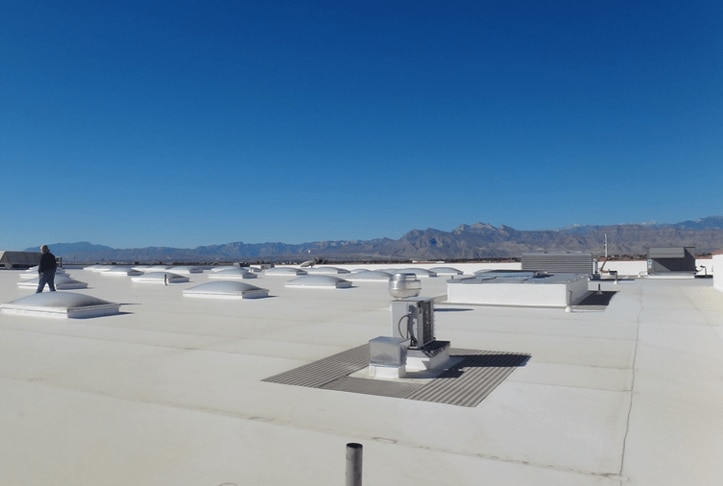Introduced as a roofing membrane in the 1960s, and first marketed in the U.S. as a commercial roof membrane in the early 1990s, thermoplastic polyolefin (TPO) has, within the last two decades, become the fastest growing commercial roof membrane on the market. TPO now represents nearly 50 percent of the installed low-slope roofing in the United States.
Analyzed extensively in laboratories and under accelerated weathering conditions, TPO has demonstrated good heat aging performance as well as UV stability. However, in part because the TPO market has experienced most of its growth in the last 20 years, it's been difficult to properly assess historical, in-the-field TPO performance.
Until now.
Today, many TPO roofs in the United States have been in service for over 20 years. So in order to assess performance and the ability to repair aged TPO roof membranes, GAF acquired samples from 20 aged roofs located throughout the United States, installed over office buildings, manufacturing facilities, retail outlets, libraries, automotive repair shops, warehouses, and a grocery store. These 20 samples represent the start of an ongoing study, with more samples to be collected.
These samples were analyzed, focusing on known failure modes including erosion of the cap (thickness over scrim) down to the scrim and surface cracking, as well as concerns surrounding the ability to repair TPO membranes as they age.
A GAF team that includes Director of Building and Roofing Science Jennifer Keegan, AAIA, and Building and Roofing Science Architect Jim Kirby, AIA, presented the results of these findings in Proven Performance – Aged TPO Field Study, prepared for the 2020 IIBEC Convention. The study and report are just the beginning of an ongoing effort by GAF to assess the performance and ability to repair aged TPO roof membranes.
Study Overview
For in-depth details, methodology and findings of the Proven Performance study, we advise readers to download the entire report. The following is a high-level summary:
Sample Selection:
- Membrane samples were collected from roofs around the United States that were at least 12 years in service and could offer a general sense of typical performance in various locations. Access and availability of the owner were a governing factor.
- The oldest sample reviewed to date was installed in 2001.
- All samples were from the same manufacturer and were predominantly 45 and 60-mil smooth-back membranes. All samples were taken from mechanically attached, induction welded, and adhered roofs. (i.e. no self-adhered samples)
- When possible, two samples were taken from each roof. Each was 2-foot by 3-foot and captured a field-welded seam.
- The large samples were cut into smaller pieces to evaluate membrane thickness, thickness over scrim, brittleness, heat aging and weather resistance, ply adhesion of existing welds, and ply adhesion of repair welds.
Test Program and Results Overview
The testing program was built around ASTM D6878-19, with modifications as needed for aged samples. The artificial aging tests were replaced with field aging for a minimum of 12 years. All tests were conducted in a commercial test laboratory and all data gathered was used in the analysis.
Overall, the aged TPO membrane roofs in this study are performing well and, in most instances, meeting the current ASTM D6878-19 requirements for newly manufactured membranes.
- Even after 12 or more years of aging, both the 45 and 60-mil membrane samples exceeded current thickness requirements for newly manufactured TPO membranes.
- Both the 45 and 60-mil membranes analyzed in this study are still in compliance with these newly-manufactured membrane requirements, with the thickness over scrim averaging over 40-percent of the actual aged membrane thickness.
- All of the samples, both the 45 and 60-mil membranes, exhibited no signs of cracking when bent over the mandrel and viewed at 7X magnification.
- All of the 60-mil samples tested to date still meet cold temperature flexibility requirements after 12 or more years of aging. The 45-mil samples showed signs of cracking at -40°F. While this is still good performance and aged membranes cannot be expected to perform at the same level as new membranes, the data supports the use of thicker membranes for longer term performance.
- Ply adhesion values of the aged TPO membrane were 15-percent above the average ply adhesion value from the SRI study on new TPO membranes. As expected, the aged welds appear to be performing well and are of adequate strength.
- Ply adhesion values of new repair membrane to the aged TPO membrane are above the average ply adhesion value for new TPO membranes. This provides some validity to the integrity of properly executed repairs to aged TPO membranes.
Download the Proven Performance — Aged TPO Field Study: gaf.com/tpostudy

